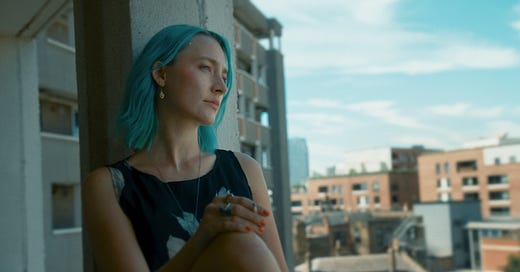Addiction, Saoirse Ronan tells us in voiceover midway through The Outrun, “leaves our neural pathways … so scarred that they’ll never be repaired.” She’s speaking as Rona, a graduate student on the cusp of her thirties who is teetering on the edge of self-destruction. Rona is an alcoholic. She’s abandoned her studies and her work for the bottle. When we first meet her, she’s 117 days sober, has managed to graduate from a rehab program, and has temporarily moved home from London to the Orkney Islands—a chain off the northern end of Scotland—to help her parents with lambing season. It’s just for a few more days, she tells herself and everyone else. Once she’s back on her feet, she’ll go back to London and pick up the threads of her old life.
Alcoholism changes your relationship with time until you measure out your life from drink to drink. Sobriety isn’t just abstinence; it’s a complete rebuilding of your life into a new shape. The warped relationship with time still exists, though: instead of counting down until your next drink, you must measure your life in the minutes, days, and years since you had your last. Recovery is hard work. The Outrun is an attempt to take stock of the fragile in-between part of recovery, the moments in which Rona is still unearthing the person she wants to be in sobriety.
The film works best as a showcase for Saoirse Ronan’s talent as a performer (she also co-produced the film). Present-day Rona is a prickly character in her early sobriety; in flashbacks, she is much more free and easygoing, at least until the drink takes hold. Her awfulness—to her partner, her friends, her coworkers—is hinted at more than it is explored. Ronan’s performance is the kind of work that is easy to call “fearless” because she isn’t afraid to be ugly in her portrayal of addiction and recovery. She’s good enough that the rest of the movie has a difficult time keeping up with her.
Part of the trouble is that the film mixes its metaphors. Sometimes The Outrun equates sobriety with the gales that shake the Orkney Islands; sometimes it suggests that sobriety is simply the act of riding out those same storms. Occasionally the film highlights a parallel between Rona’s retreat back home and a sort of monasticism, but the substance of the parallel is thin. It is mystical without any transcendence. In sections that appear to be lifted directly from the memoir the movie adapts, we’re told about the storms, wildlife, and traditional lore of the islands. We learn that the Orkneys are said to have sprung up from the lost teeth of a legendary dragon and that drowned humans can come back as selkies, or seal people. If the lore of the Orkneys is meant to shed light on Rona’s recovery, the intended effect is unclear. Metaphors, especially in film, need not be explained plainly, but the connections between Rona’s life and her environment are so thin that they break, and we’re left scrambling to make an account ourselves.
Still, the movie manages some striking imagery: Rona laid out atop a table at a party, her arms outstretched to either side and her head thrown back to make upside-down eye contact with a fellow partygoer and future boyfriend (played by Paapa Essiedu). At the party, she looks like a sea creature through a curtain of blue hair and glitter and the shine of green lights. Crash forward several months, and Rona finds herself confronted by actual sea creatures in the form of seals, their dark eyes and smooth heads poking above the waves to watch her as she stands, freezing, on the rocky shores of the North Atlantic.
And that’s it. We watch Rona take uncertain steps into a new identity: at first resentful, then slowly more confident, reclaiming the joy that she thought she’d had with alcohol but that alcohol had stolen from her. She digs through seaweed, beachcombing until she finds a little ceramic figurine, headless and limbless but still distinctly human. At its best, The Outrun hints at the hard work of recovering, of reclaiming one’s identity from the grip of addiction. At its worst, the film draws a straight line from recovery to humanity, a schematic diagram that oversimplifies the story it’s trying to tell. —Sarah Welch-Larson
★★☆☆
The Outrun is in limited theatrical release.





